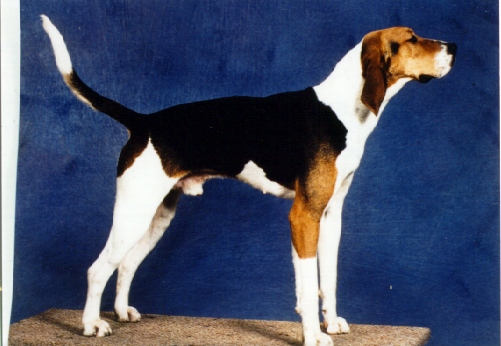

The Treeing Walker was developed from certain stains of English Walker Foxhounds. The credit for the development of the Walker Foxhound goes to two men George Washington Maupin and John W. Walker. Both men were from Kentucky.
Before that time Thomas Walker of Albermarle County, Virginia, imported hounds from England in 1770. These dogs became the foundation of the "Virginia hounds", which were developed into the Walker Coonhound.
At least one major outcross was made in the 19th century that was to forever influence the breed. Strangely, the outcross was with a stolen dog from Tennessee Lead.
Lead didn't look like the Virginia strain of English Foxhounds of that day. But he had an exceptional amount of game sense, plenty of drive and speed and a clear, short mouth.
Walkers were forst registered with UKC as part of the English Coonhound breed. Then in 1945, at the request of Walker breeders, UKC began registering them as a seperate breed, first as Walkers(Treeing) and then later as Treeing Walkers.
SKULL: Head is carried well up. Occipur bone prominent; cranium broad and full. Head is pleasing Proportionally to body.
EARS: Of medium length set moderately low. Should hang gracefully, inside part tipping toward muzzle. Should not be to pointed at tip, but slightly rounded or oval, soft and velvety, hanging with a tendency to roll when head is raised. In proportion to head and body.
EYES: Moderately prominent; set well apart. Open soft and expressive. Dark in color; Brown or Black.
MUZZLE: Medium square, rather long. Slightly tapering, with flews sufficient to give a rather square appearance. Stop not to prominent, not to abrupt.
NOSTRILS: Rather large, prominent and black. A slightly sloping nostril not objectionable. Faults: other colors.
TEETH: Should meet, not overshot or undershot.
DEFECTS: A very flat skull, narrow across the top. Excess of dome. Eyes small, sharp and terrier like: to protruding. Muzzle long and snipy, cut away below eyes too much, or very short. Roman nosed, or unturned, giving a dished faced expression. Ears short, set high or with a tendency to rise above point of origin.

NECK & THROAT: Neck rising free and light from the shoulders. Strong in substance, yet not loaded. Of medium length. Throat should be clean and free from folds of skin. A slightly wrinkle below the angle of the jaw, however, is allowable.
DEFECTS: A thick short neck carried on a line with the top of the shoulders. Throat showing dewlaps and fold of skin. Too throaty.
SHOULDERS, CHEST AND RIBS: Shoulders sloping, clean, muscular. Not loaded or heavy in appearance. Conveying the idea of freedom of action, springless, with activity and strength. Chest should be deep for lung space. Look for depth rather than width. Well-sprung ribs. Back ribs should extend well back, about a three inch flank allowing for springiness.
DEFECTS: Straight upright shoulders. Chest disproportionately wide, or with lack of depth. Flat ribs.
BACK AND LOINS: Back moderately long, muscular and strong. Loins broad and slightly arched.
DEFECTS: Very long, swayed or roached back. Flat, narrow loins.
FORELEGS: Straight, with a fair amount of bone. Pasterns short and straight.
FEET: Solid, compact, well padded, giving a cat-like appearance. Well arched toes, strong nails for quick get away.
DEFECTS: Out at elbow. Knees knuckled over forward, or bent backward. Forelegs crooked. Feet long, open or spreading.
HIPS, THIGHS, HINDLEGS AND FEET: Hips and thighs strong and well muscled, giving abundance of propelling power. Stifles strong and well let down. Hocks firm, symmetrical and moderately bent. Feet close and firm.
DEFECTS: Cowhocks, or straight hocks. Lack of muscle and propelling power. Open feet.
TAIL: Set rather high. Strong at root. Tapering moderately long without flag. Carried free, well up, saber-like. Curved gracefully up and foreward.
DEFECTS: Too long. Rat tail. Entire absense of brush.
COAT: Smooth haired. Glossy, fine, yet dense enough for protection. A close, hard, hound coat.
DEFECTS: Short, thin coat, or of soft quality.
COLOR: Tri-colored is preferred, white-black-tan. White may be predominate color, with black spots and tan trim; or black may be predominate color with white markings and tan trim, such as saddle back, or blanket back. White with tan spots or white with black spots may be accepted.
DEFECTS: Any other color combination will be penelized when shown.
SYMMETRY OF CONFORMATION: Of great importance. Denotes quality.
DEFECTS: Poor conformation.
VOICE: Preferably a clear, ringing, bugle voice; or a steady, clear chop. Noticeable change at tree.
HEIGHT: Slightly more at shoulders than at hips. Shoulders should measure: Males, 22 to 27; Females, 20 to 25.
WEIGHT: Should be in proportion to dogs height. Working dogs not to be penelized when shown if slightly under.
QUALITIVE CHARACTERISTICS: Energetic, intelligent, active, courteous, composed, confident, fearless, kind, graceful in pose while active. Super abundence of sense, endurance, trailing, hunting and treeing instinct ability.
NOTICE: Working dogs will not be penelized, under any conditions, for scars or blemishes due to hunting injuries.
POINTS
Head...........................................................10
Neck...........................................................5
Shoulders....................................................10
Chest & Ribs...............................................10
Back & Loins..............................................15
Hindquarters................................................10
Elbows.........................................................5
Legs & Feet.................................................20
Coat & Color...............................................5
Stern............................................................5
General Make-up.........................................5Total.................................................................100